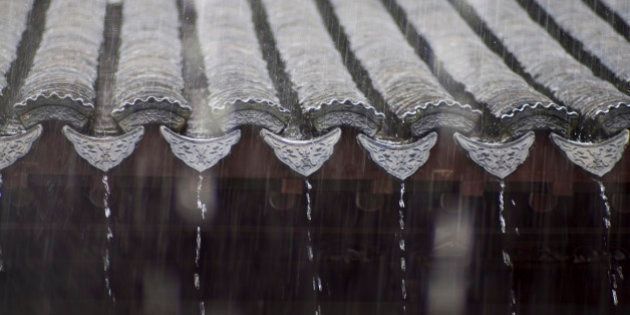
Kerala is a land of paradoxes, where rainfall exceeds 3 metres a year and yet there is a drought every summer. Thrissur district in the central part of Kerala has hills on the east and the Arabian Sea on the west. Each summer, wells dry up and people call in tankers. In the coastal areas, the groundwater is saline, as seawater has entered the aquifers. In the mid-altitudes, water quality is compromised by untreated sewage from towns and villages as well as leachates from pit toilets. In rural areas, households are far apart, making piped water schemes costly. People use their wells as the water source.
In a few panchayats like the Adat grama panchayat (GP), about 12km from Thrissur, tube wells have been installed to supply water during the summer months. However, the water from these has a high content of iron that spoils the taste and stains clothes. Additionally, there are concerns about rapidly depleting aquifers because of urbanization. This pattern is repeated across the other GPs in the district. People grow rice in low-lying coastal areas from there they pump out excess water during the rains; this has exacerbated the decline in aquifers.
The basic tenets are simple. Collect rainwater from the rooftop, run it through a sand filter and then into the well on the homestead.
On the other hand, during the monsoons, parts of the district get flooded or waterlogged. Most of the rain washes off into the sea, taking the rich topsoil with it. For a few months, the soil retains the water and wells are full before the cycle starts again.
The approach
Concerned by recurrent droughts from March to May every year, the administration of the Thrissur district decided to do something different. The administration has to call in hundreds of tankers to provide water at huge expense. This irked the then (2008) District Collector, Dr V Kurian Baby.
He consulted with local experts and devised a simple solution -- channel the abundant rainfall into wells that are ubiquitous in Kerala. Thrissur has 450,000 and the state, about 10 times that number. They represent the state's collective investment in water security as over 70% use well water for all their needs.
Baby says this investment probably exceeds ₹1,800 crore, all private. The state government in this year's vote on account has set aside more than ₹90 crore for Mazhapolima, as the rainwater-linked well recharge scheme is called. A government order in February specified the institutional structure for running the project: a state-level monitoring committee headed by the Principal Secretary for Local Self-Government, district committees headed by the district collector for planning and panchayat committees for implementation.
The cost was ₹5000 per household for the pipes and any other material. Householders do the work themselves... It takes less than a week to set up a system...
This approach integrates water security with livelihoods. In panchayats, the state women's self-group organization called Kudumbashree, the sarpanch and other officials form the core team. There are technical experts to support individual households. Linking with Kudumbashree helps poor families access credit. People can use funds from the Mahatma Gandhi National Rural Employment Guarantee Scheme for materials and labour.
The basic tenets are simple. Collect rainwater from the rooftop, run it through a sand filter and then into the well on the homestead. PVC pipes were fixed to the rafters protruding from the edges of roofs. These were connected to a common descending pipe that led into a sandpit. From there another pipe took the water into the well.
The cost was ₹5000 per household for the pipes and any other material. Householders do the work themselves, with hired help if needed. It takes less than a week to set up a system for a typical Kerala house. The catchment is ready-made with tiled roofs on most homes.
Impressive progress
The journey from experiment to policy has been long. In 2008, a United Nations-sponsored initiative called Solution Exchange ran an e-discussion on Mazhapolima. The idea was to seek ways to popularize the programme and innovative ways to finance it. Mazhapolima captured the national imagination as a way to address annual droughts in many parts of the country.
The following year, Solution Exchange and the administration held a workshop on water issues in South India. The then principal secretary for revenue and disaster management Nivedita Haran announced the government would give ₹1 crore to the district. In 2013, another ₹2 crore was announced for the programme. In this year's budget the state government set aside ₹93 crore for this programme across the state. Mazhapolima has gone from a proof of concept to being a corner-stone of the state's water security.
Mazhapolima captured the national imagination as a way to address annual droughts in many parts of the country.
It has worked because it has been community-driven and participatory, planning is bottom-up and led by panchayats, while the state government facilitates. It is a process-oriented programme encouraging innovation and diversity. Setting up a household system is inexpensive.
As a result, groundwater levels have improved significantly in Thrissur. The larger twin benefits of improving quality and quantity will become apparent after rainfall has been channelled into wells across the state.
Outlook
However, early studies point to a worryingly high persistence of bacterial contamination in groundwater. This comes mostly from pit toilets near the wells owing to the high porosity of the soil. While there is a good demand from some areas for the project, others have yet to show enthusiasm. Where demand is high the project has also helped people leverage other government schemes through social capital built for Mazhapolima.



Contact HuffPost India
Also see on HuffPost:
